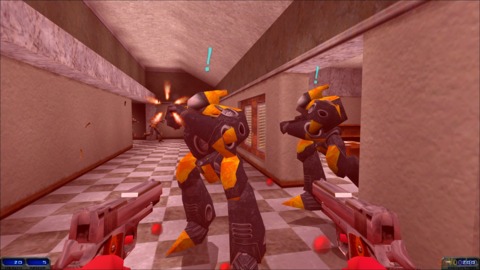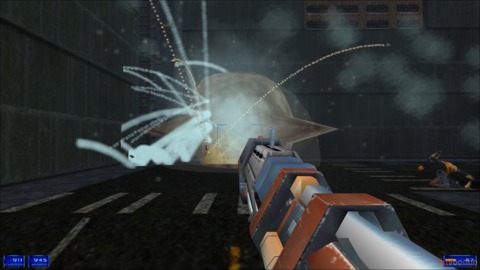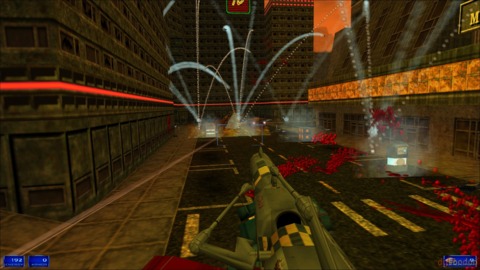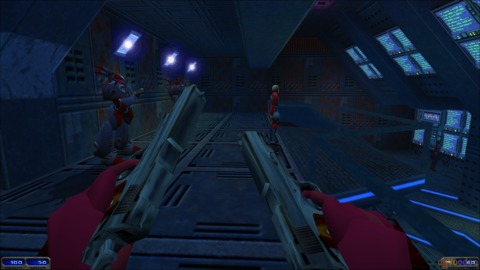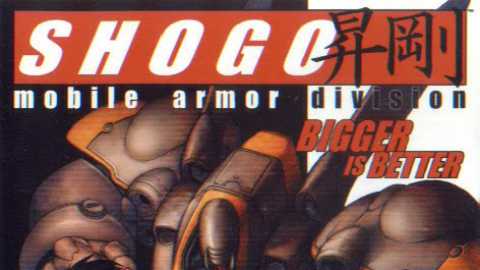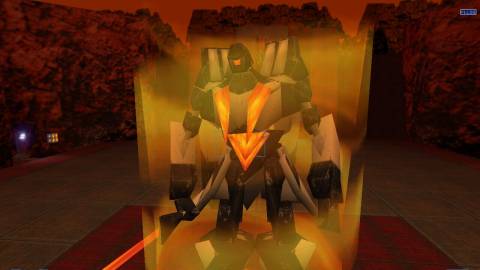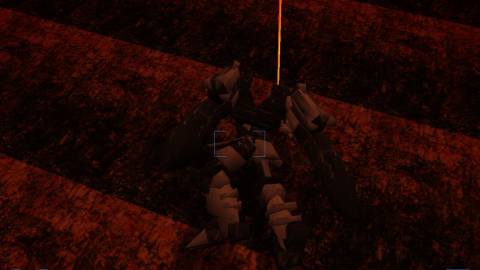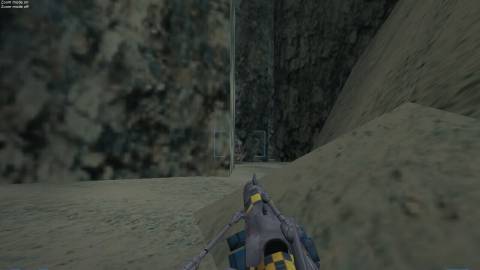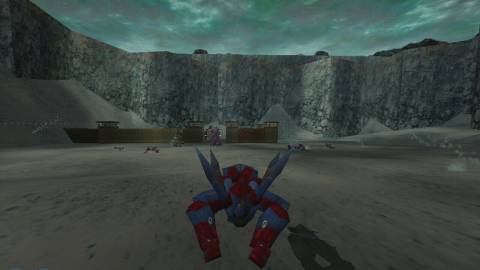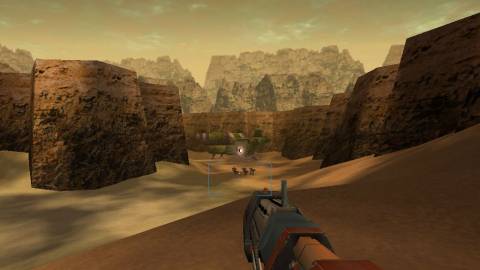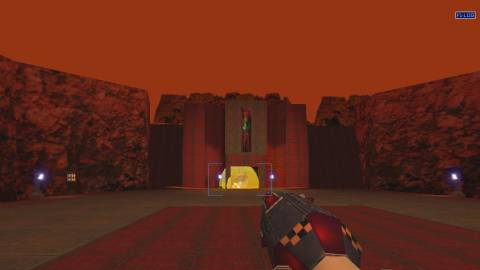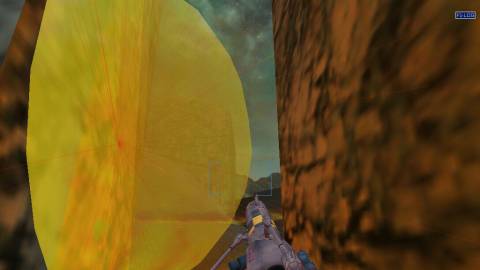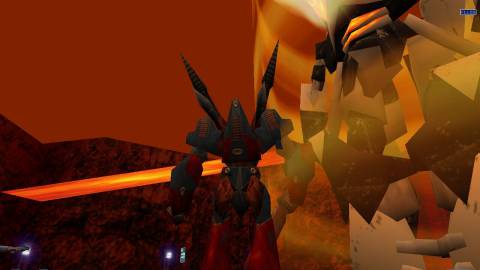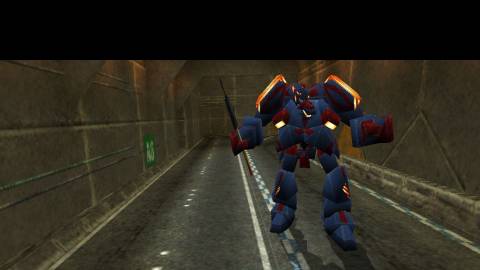Overview

Shogo: Mobile Armor Division is a first person shooter developed by Monolith Productions, released in 1998. The game features combat in mechs, known as MCAs (Mobile Combat Armor) in the Shogo universe, as well as more conventional on-foot shooting with standard FPS weapons such as assault rifles, sub-machine guns, shotguns, etc. At the beginning of the game, the player may choose one of four available MCAs to pilot. Each MCA has different statistics and speed, but all can all use the same weapons. Each level in the game takes place either entirely on-foot or entirely in an MCA, as the player cannot get in or out of MCAs during gameplay.
Shogo was also one of the first standard FPS games to feature a branching storyline, in which the player can choose sides and take a different path through the story. The branching point occurs about 80% of the way into the game. One path (siding with Gabriel) results in more on-foot action and the other (siding with the UCA) is more MCA-oriented. The two paths also feature completely different missions and different endings.
On April, 14th 2017 the game was re-released on the digital store front Steam.
Story
Players control Sanjuro Makabe, an MCA pilot working for the UCA (United Corporate Authority) under Commander Nathaniel Akkaraju of the UCASF flagship Leviathan. The UCA main mission is to fight against a terrorist organization known as the Fallen. The action takes place in different locations around the planet Cronus. Both the UCA and the Fallen seek to control a rare energy source called Kato, only found on Cronus. Prior to the start of the game Sanjuro had lost his brother Toshiro, his childhood friend Baku, and the woman he loved, Kura Akkaraju, to a massive earthquake that struck while they were on a mission to assassinate the former leader of the Fallen, Ivan Isarevich. When the game begins, Sanjuro is dating Kathryn, Kura's sister. Sanjuro seeks to avenge his fallen comrades in the war on Cronus.
On Cronus, Sanjuro fights his way through the city of Avernus to the place where his friends and brother were killed. Along the way he meets Hank Johnson, a local survivor who helps him out after he loses contact with Kathryn. Soon after, Sanjuro crosses paths with Ryo Ishikawa, the leader of an enigmatic third faction called Shogo. Ryo explains that Sanjuro's friends weren't actually killed in that fateful battle long ago. In fact, Baku had joined Shogo under the alias of Uziel, Toshiro had joined the Fallen, and Kura had rejoined the UCA where she was working deep undercover, which necessitated that Sanjuro not be informed of her survival.
Sanjuro sets off to meet up with Kura, but before he can reach her, she gets captured by local security. Sanjuro rescues her with Ryo's assistance, but Hank is killed in cold blood by Ryo, right before Sanjuro's eyes. Kura tells Sanjuro that his brother, Toshiro, has not joined the Fallen by choice, but rather has been mind-controlled by an ancient alien creature called Cothineal that is using the Fallen to do its bidding. Under the Cothineal's influence, Toshiro has become Gabriel, leader of the Fallen. Admiral Akkaraju won't hear of this, however, and in defiance of the UCA high command, he begins preparing to fire the Leviathan's Kato cannon at Avernus to exterminate the Fallen once and for all, collateral damage be damned.
At this point, Sanjuro must make a choice: either join the Fallen and turn against the UCA to stop the Admiral from firing the Kato cannon at Avernus, or stay loyal to the UCA and fight his puppet brother to destroy the Fallen. Either way, Sanjuro encounters Ryo along the way, who is playing all sides and working with whomever Sanjuro turns against, providing Sanjuro the opportunity to kill Ryo, which he does.
If Sanjuro sides with the UCA, he travels back through Avernus to find and attack the Fallen's hidden fortress. There, he encounters his childhood friend Baku and kills him in UCA combat. He then finds Gabriel protected by feeding off the energy of Cothineal. Sanjuro shoots Cothineal enough to weaken him, exposing Gabriel long enough to kill Gabriel, and thus freeing Toshiro who is psychologically traumatized. With the Fallen defeated, the Admiral backs down from firing the Kato cannon. The Admiral's daughters, Kathryn and Kura, flirt with Sanjuro. The end.
If Sanjuro sides with Gabriel and the Fallen, he attacks and infiltrates the Leviathan, sabotages the ship's systems, guns his way through the crew, and finally finds the Admiral, who initiates the Kato cannon firing sequence. Sanjuro halts the firing sequence just in the nick of time, stopping the Admiral, who is arrested and court marshaled. The Admiral's daughters, Kathryn and Kura, flirt with Sanjuro. The end.
Development
In a 2001 Gamasutra post-mortem of No One Lives Forever, Craig Hubbard, the creative director on Shogo, described Shogo as a game that "fell embarrassingly short of our original design goals". Furthermore, he said, "the only thing that saved Shogo from complete disaster was the realization, some six months before we were supposed to ship, that there was no way to make the game great in that amount of time. So, we concentrated on making it fun.... The intended scope of the project was so grand, particularly for such a tiny team, that we were overwhelmed just trying to get everything into the game. As a result, we didn't have time to polish any of it. The final product is barely more than a prototype of the game we were trying to make, even after we cut characters, settings, story elements, and whatever else we could jettison without breaking the game.... I'm certainly proud of Shogo as an accomplishment, but as a game it is a grim reminder of the perils of wild optimism and unchecked ambition."
Multiplayer
The multiplayer mode lets players choose between infantry maps and MCA maps. Scattered around the maps are health pickups, armor pickups, power ups, and weapons. All the weapons from the single player mode are available in multiplayer. Players can also choose one of the four MCAs for multiplayer. Multiplayer continues to have fanbase and fan made updates for the game have been release which address balance and cheating.
Mods
There are several mods for Shogo, although most of them are incomplete. There were promising mods such as Greased With Lovin', which attempted to improve the game experience overall with better balancing, A.I. and etc. There are also many of custom maps for Shogo available on the web. An editor as well as the original Shogo source code have been released and are available for download.
Planned Expansions and Sequel
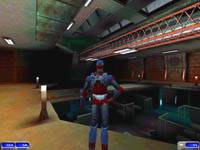
An expansion called Shugotenshi was planned. The expansion would have allowed the player to play as Kura, seeing the story from her perspective. It appears that the expansion was quite far along in development, but was never completed. The title roughly translates to "guardian angel", which would have referred to Kura's role as Sanjuro's secret protector. Some speculate that the expansion was cancelled because the original game did not sell well. The reason for poor sales may have been Shogo's release just a month before Half-Life.
Another expansion was called Legacy of the Fallen and would have five new MCAs, six new infantry weapons and five new MCA weapons and would take place on a kato mining facility at Iota-33. There would be a new story explaining the Fallen and their structure and have a cast of new characters. Also, the level-structure would have been more like Half-Life, where players enter and exit levels seamlessly, with just a "Loading" text on screen.
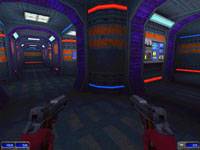
Shogo 2 or a sort of expansion pack was planned and was supposed to use a new graphics engine, there are very few pictures of this but there are some tech demo screens and very little is known about this game. During the end of Shogo it says "Expect more games in the Shogo saga!" so this was probably the true sequel in works. Monolith have not announced Shogo 2 or any other Shogo games since then, however, during a demonstration of F.E.A.R. 2: Project Origin, they said that they had wanted to do destructible environments in Shogo, and that they were able to do that now in Project Origin with their mech unit, so this combined with all the trivia for Shogo in F.E.A.R. shows they haven't forgotten about Shogo.
Additional Information
Commander Claw!
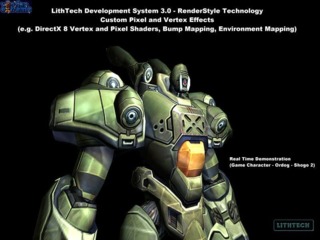
Monolith's pirate-themed 2D-platformer Claw (released in 1997) is referenced in this game. The main character of the game, Captain Nathaniel Joseph Claw, is represented as a doll that the player can collect as part of a side mission in Shogo. His first name, Nathaniel, is also shared with Admiral Nathaniel Akkaraju in Shogo.
Anime References
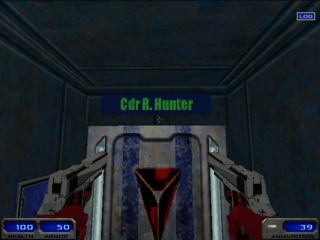
In the Leviathan there are various doors leading to the rooms of some quite famous anime characters. Players have M. Kusanagi (Motoko Kusanagi from Ghost in the Shell), R. Hunter (Rick Hunter from Robotech/Macross), N. Izumi (Noa Izumi from Patlabor) and there is a poster showing a logo for "CURV", done in the same way as the NERV logo from Neon Genesis Evangelion. In a chat-log from when the game was called Red Riot (which is also the name of the final MCA weapon in the game) players can see that they talked about different anime like Ghost in the Shell and Neon Genesis Evangelion.
Intro Childhood Sequence
During the intro cinematic, a young Sanjuro is seen running towards a basketball hoop. This is part of a sequence that was to be in the game but was removed before the final release. The childhood sequence was likely planned in order to provide some more back story about Toshiro, Baku, and Kura.
F.E.A.R. Connection
Some of Shogo's legacy lives on in the game F.E.A.R. also by Monolith. There are weapons that are very similar to the ones in Shogo. in addition there is a secret room in F.E.A.R. where the theme music from Shogo can be heard. The building in which F.E.A.R. takes place in is owned by Armacham, which is a company in SHOGO that produces MCAs, specifically the Armacham Ordog Advanced Series 7, or just Ordog for short.
Not included content
In the opening movie of the game some characters, mechs, and at least one level that was supposed to be in the final retail version is shown but has no traces of it in the actual game. The level shows a male child (possible Senjuro) running in a basketball. In addition to this, the manual states that there is an 'armor upgrade' that can grant players a new MCA (Mobile Combat Armor), possible the one that is shown in the opening sequence, however such an item does not exist. In the final months of development, Shogo experienced drastic content cuts in order to reach completion.

 Amiga
Amiga Mac
Mac PC
PC
